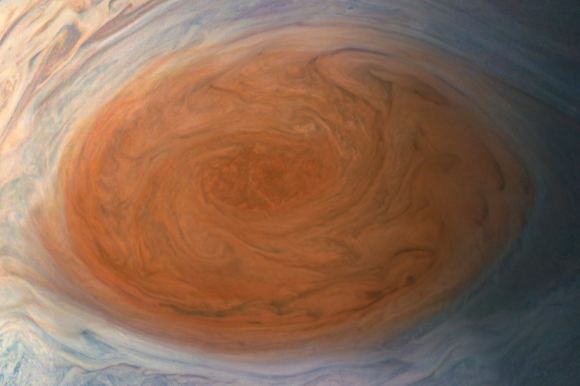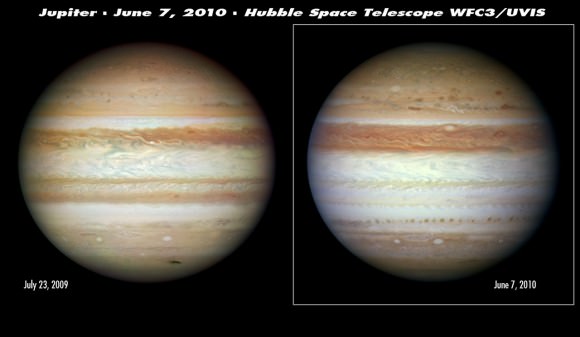The largest storm in the Solar System is shrinking and planetary scientists think they have an explanation. It could be related to a reduction in the number of smaller storms that feed it and may be starving Jupiter's centuries-old Great Red Spot (GRS).
This storm has intrigued observers from its perch in the Jovian southern hemisphere since it was first seen in the mid-1600s. Continuous observations of it began in the late 1800s, which allowed scientists to chart a constant parade of changes. In the process, they've learned quite a bit about the spot. It's a high-pressure region that generates a 16,000 km-wide anticyclonic storm with winds clocking in at more than 321 km per hour. The storm extends down through the atmosphere to a depth of about 250 km below the mainly ammonia cloud tops.
Modeling a Shrinking and Growing Great Red Spot
Over the past century, scientists noticed the GRS shrinking, leaving them with a puzzle on their hands. Yale Ph.D. student Caleb Keaveney had the idea that perhaps smaller storms that feed the GRS could play a role in starving it. He and a team of researchers focused on their influence and conducted a series of 3D simulations of the Spot. They used a model called the Explicit Planetary Isentropic-Coordinate (EPIC) model, which is used in studying planetary atmospheres. The result was a suite of computer models that simulated interactions between the Great Red Spot and smaller storms of varying frequency and intensity.
A separate control group of simulations left out the small storms. Then, the team compared the simulations. They saw that the smaller storms seemed to strengthen the Great Red Spot and make it grow. "We found through numerical simulations that by feeding the Great Red Spot a diet of smaller storms, as has been known to occur on Jupiter, we could modulate its size," Keaveney said.
If that's true, then the presence (or lack thereof) of those smaller storms could be what's changing the spot's size. Essentially, a lot of smaller spots cause it to grow larger. Fewer little ones cause it to shrink. Furthermore, the team's modeling supports an interesting idea. Without forced interactions with these smaller vortices, the Spot can shrink over a period of about 2.6 Earth years.
Using Earth Storms as a Comparison
The Great Red Spot isn't the only place in the Solar System that sports such a long-lived high-pressure system. Earth experiences plenty of them, usually called "heat domes" or "blocks." Most of us are familiar with heat domes because we experience them during the summer months. They happen frequently in the upper atmosphere jet stream that circulates across our planet's mid-latitudes. We can blame them for some of the extreme weather people experience—such as heat waves and extended droughts. They tend to last a long time, and they are linked to interactions with smaller transient weather such as high-pressure eddies and anticyclones.
Given that the Great Red Spot is an anticyclonic feature, it has interesting implications for similar atmospheric structures on both planets, according to Keaveney. "Interactions with nearby weather systems have been shown to sustain and amplify heat domes, which motivated our hypothesis that similar interactions on Jupiter could sustain the Great Red Spot," he said. "In validating that hypothesis, we provide additional support to this understanding of heat domes on Earth."
The Ever-changing Great Red Spot
In addition to the changing size of the Great Red Spot, observers also notice shifts in its color. It's mainly reddish-orange but has been known to fade to a pinkish-orange hue. The colors suggest some complex chemistry occurring in the region spurred by solar radiation. It has an effect on a chemical compound called ammonium hydrosulfide as well as the organic compound acetylene. That creates a substance called a tholin, which gives a reddish color wherever it exists.
At times the spot has nearly disappeared altogether due to some complex interaction with a feature called the Southern Equatorial Belt (SEB). The SEB is where the spot is located, and when it is bright and white, the spot goes dark. At other times, the reverse color change happens. In some cases, the SEB itself has disappeared at various times. No one is quite sure why this is happening, but it's one more piece of the Jovian atmospheric puzzle.
Changes to the Great Red Spot have been studied extensively not just from the ground, but also by spacecraft missions, beginning with Voyager and extending through the Galileo, Cassini, and Juno missions. Each spacecraft used specialized instruments to probe the spot, measure its windspeeds and temperatures, and sample the gas and compounds in the upper atmosphere. All of that data feeds models like the ones used at Yale to model the smaller storms' contributions to the Great Red Spot's growth and shrinkage.
For More Information
A New Explanation for Jupiter's Great, Shrinking "Spot"
Effect of Transient Vortex Interactions on the Size and Strength of Jupiter's Great Red Spot Juno and the Great Red Spot
 Universe Today
Universe Today


